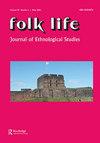The language of the printing-house: why so many books in Welsh and Scottish Gaelic were printed in 18th-century Ireland, and so few in Irish
IF 0.1
4区 社会学
0 FOLKLORE
引用次数: 0
Abstract
ABSTRACT Among the principal Celtic languages, Irish is conspicuous for the paucity of printed production between the seventeenth and the nineteenth centuries. Various explanations have been advanced for this by Irish scholars and historians. Among them number suggestions that, since printing was an urban phenomenon, and since towns in Ireland were largely English-speaking, printers therefore lacked the necessary language skills. This paper evaluates such explanations through an exploration of printing in Ireland of texts in Celtic languages other than Irish. More was printed in Welsh than in Irish in Dublin in the 1740s and 1760s, while two substantial collections of poetry in Scottish Gaelic were printed in Cork and Galway around 1800. The paper concludes that Irish printers could work in different languages, and their supposed lack of linguistic skills was not therefore a major factor in preventing the production of printed Irish.印刷厂的语言:为什么18世纪的爱尔兰印刷了那么多威尔士语和苏格兰盖尔语的书,而爱尔兰语的书却很少
在主要的凯尔特语言中,爱尔兰语在17世纪到19世纪之间印刷产品的匮乏是显而易见的。爱尔兰学者和历史学家对此提出了各种各样的解释。其中有许多建议认为,由于印刷术是一种城市现象,而爱尔兰城镇的居民大多说英语,因此印刷工人缺乏必要的语言技能。本文通过对爱尔兰的凯尔特语而非爱尔兰语文本的印刷的探索来评价这种解释。在18世纪40年代和60年代,都柏林用威尔士语印刷的诗歌比用爱尔兰语印刷的要多,而在1800年左右,科克和戈尔韦印刷了两本大量的苏格兰盖尔语诗集。这篇论文的结论是,爱尔兰印刷商可以用不同的语言工作,他们被认为缺乏语言技能,因此并不是阻碍印刷爱尔兰语生产的主要因素。
本文章由计算机程序翻译,如有差异,请以英文原文为准。
求助全文
约1分钟内获得全文
求助全文
来源期刊
CiteScore
0.30
自引率
66.70%
发文量
17
期刊介绍:
Folk Life: Journal of Ethnological Studies is a journal devoted to the study of all aspects of traditional ways of life in Great Britain and Ireland. The journal publishes original, high quality, peer-reviewed research in the form of unsolicited articles, solicited papers (which are usually selected from those read at the Society"s annual conference) and of members" papers (which are usually short reports of work in progress). Work published in Folk Life may include, for example, papers dealing with the traditional ways of life of other countries and regions, which may be compared to or contrasted with those of Great Britain and Ireland.

 求助内容:
求助内容: 应助结果提醒方式:
应助结果提醒方式:


